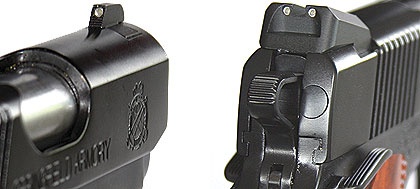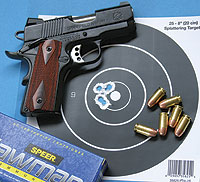January 03, 2011
By Joel J Hutchcroft
Springfield's mini- .45 is a perfect match for the compact but powerful .45 GAP cartridge
By Joel Hutchcroft
According to Shooting Times Handgun Editor Sheriff Jim Wilson, defensive shooters have been wanting big-bore handguns that are easy to conceal for more than 150 years. Since about the last half of the 19th century and well into the 21st century these "shootists" have wanted small, concealable handguns chambered for powerful cartridges.
Often referred to as pocket pistols, belly guns, and even bulldog pistols, these handguns make as much sense today as they did in the 1850s because of the number of states that have passed concealed-carry laws. Springfield Inc. (Dept. ST, 420 W. Main St., Geneseo, IL 61254; 800-680-6866; www.springfieldarmory.com) is taking big-bore pocket pistols in a new direction with its new mini .45.
Advertisement
 The Defender comes with fixed Novak rear and dovetailed front three-dot tritium night sights. |
Springfield's new mini .45, called the Defender, is a recoil-operated 1911-type single-action semiautomatic pistol chambered for the compact but powerful .45 GAP cartridge. As such, the new pistol has been scaled down in size. What's really innovative about its design is that it is not just shorter in overall length or merely a tad slimmer in profile. Its internal firing mechanism has been shortened, and consequently its grip frame has been shortened front to back. Rob Leatham, world-class shooter and Springfield spokesman, says the changes amount to about a 1/8- inch shortening (front to back) of the grip frame and the slide.
That decrease in size required resizing the magazine, the firing pin, the ejector, the extractor, the plunger tube, the plunger spring, the trigger bow, and, of course, the frame. The cumulative effect of the grip frame changes is almost a 1/4-inch reduction in grip circumference. These changes not only make the Defender's grip smaller, but according to Leatham, it actually makes the mechanism more efficient.
Advertisement
SPECS
Springfield Defender
.45 GAP Semiautomatic Pistol |
|---|
| Manufacturer: | Springfield Inc. |
|---|
| Model: | Defender |
|---|
| Operation: | Recoil-operated single-action autoloader |
|---|
| Caliber: | .45 GAP |
|---|
| Barrel Length: | 3.0 inches |
|---|
| Overall Length: | 6.6 inches |
|---|
| Weight, empty | 23 ounces |
|---|
| Height: | 4.9 inches |
|---|
| Safety: | Manual slide lock thumb safety, grip safety, internal firing pin block, Springfield I.L.S. (internal locking system) |
|---|
| Sights: | Fixed Novak rear; three-dot night sights |
|---|
| Stocks: | Cocobolo |
|---|
| Magazine Capacity: | 6 rounds |
|---|
| Finish: | Blued |
|---|
| Price: | $1184 |
|---|
Some of the Defender's other features include Novak low-profile combat-style rear sight and dovetailed front sight (the three-dot tritium night sight system), six-round magazine, 3.0-inch barrel (fitted directly to the slide), flat mainspring housing, lowered and flared ejection port, adjustable aluminum speed-style trigger, blued Commander-style hammer, ambidextrous thumb safety, beavertail grip safety, loaded chamber indicator, checkered cocobolo grip panels, and Torx head grip screws.
The sample pistol we received weighed in at 29 ounces without a magazine and was finished in a deep, glossy blue. Combine that with the rich woodgrain of the grip panels and you have a very good-looking pistol. As for the weight, Springfield's specs list the gun as weighing 23 ounces, but according to the company's literature, that's for an alloy-framed model. The review sample we got our hands on weighed more because it was a steel-framed preproduction gun.
When conducting the usual 1911 "wiggle test" (pushing on the hood of the barrel and wiggling the slide from side to side), I found the barrel to lock up nice and tight, and the slide-to-frame fit had just a small amount of wiggle. That doesn't concern me at all because this type of pistol is clearly intended for personal protection with complete reliability being more important than match-grade accuracy. Still, the slide was not as loose as a lot of old Government Models I have inspected that functioned reliably and shot accurately.
As it came from the factory, the trigger had a slight amount of takeup, but it broke crisply and consistently at 4.5 pounds of pull. I measured it with my Lyman Trigger Pull Gauge three times, and all three times it was exactly 4.5 pounds.
 Springfield's mini .45 GAP was plenty accurate for self-defense. Its best group average (1.5 inches at 15 feet) came with Speer's 185-gr. Lawman loads. |
Plenty Powerful & Accurate Too
My shooting tests with the .45 GAP Defender were done using seven different factory loads: Federal's 185-grain Hydra-Shok, Speer's 185-grain Gold Dot and Lawman TMJ, Speer's 200-grain Gold Dot and Lawman TMJ, and Winchester's 185-grain Silvertip and 230-grain FMJ. I fired four five-shot groups with each of the loads from a sandbag benchrest at a self-defense distance of 15 feet.
The test ammunition gave good combat accuracy with the groups averaging from 1.50 to 2.25 inches. The consistently most accurate round in the Defender during my shooting review was the Lawman 185-grain TMJ loading from Speer. Velocities from the three-inch barrel averaged 942 fps overall, with the highest being turned in by Federal's 185-grain Hydra-Shok (981 fps). But the difference between it and the second highest velocity load (Speer's 185-grain Gold Dot) was only one fps, so on another day of shooting the ranking could conceivably change.
Winchester's heavy 230-grain FMJ load produced the lowest average velocity (820 fps). All loads compared favorably to .45 ACP factory ammunition fired through a three-inch-barreled pistol. (I recently test-fired a three-inch-barreled Kimber Ultra Raptor II in .45 ACP and for factory loads with the same bullet weight range [185 to 230 grains], it averaged 814 fps.)
The Defender was very comfortable to shoot. As for functioning, well, short-barreled .45 ACP 1911 pistols, regardless of brand, are known to be picky when it comes to what ammunition will run through them flawlessly. That doesn't appear to be a problem with the .45 GAP Defender. It was exceptionally reliable.
To my way of thinking, the most unique feature of the Springfield Defender is its size. The gun is, to put it in a single word, dainty. But don't take that the wrong way. In the hand it feels like a real gun, and it is plenty stout enough to handle comfortably when firing the .45 ACP-equivalent .45 GAP cartridge.
| Shooting Springfield's .45 GAP Defender |
|---|
| Factory Load | Muzzle Velocity (fps) | Standard Deviation (fps) | Extreme Spread (fps) | 15-foot Accuracy (inches) |
|---|
| Federal 185-gr. Hyrda-Shok | 981 | 17 | 44 | 2.00 |
|---|
| Speer 185-gr. Gold Dot | 980 | 14 | 39 | 1.75 |
|---|
| Speer 185-gr. Lawman TMJ | 975 | 11 | 35 | 1.50 |
|---|
| Winchester 185-gr. Silvertip | 970 | 20 | 50 | 2.00 |
|---|
| Speer 200-gr. Gold Dot | 920 | 12 | 36 | 1.75 |
|---|
| Speer 200-gr. Lawman TMJ | 950 | 18 | 47 | 1.75 |
|---|
| Winchester 230-gr. FMJ | 820 | 16 | 45 | 2.25 |
|---|
| NOTES: Accuracy is the average of five five-shot groups fired from a sandbag benchrest at 15 feet. Velocity is the average of 20 rounds measured 15 feet from the gun's muzzle. |
The 200-grain factory loads were noticeably the most comfortable to shoot, but I am confident that even small-stature defensive shooters can handle any of the factory ammunition easily. And the pistol is plenty accurate for its intended purpose of personal protection.
The .45 GAP Defender is a slim, compact defensive handgun that is chambered for a powerful, fight-stopping caliber. Its sights are easy to pick up quickly, in both bright light and low light conditions. It is very comfortable to shoot, and it is plenty accurate.
I like the direction Springfield is taking with this small, reliable pocket pistol. I think you need to check out one for yourself.

